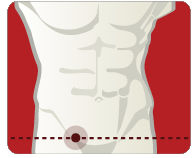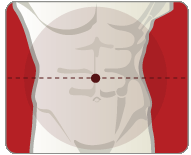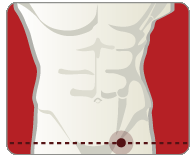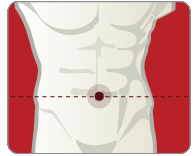Hernias
We want informed patients
If you know the signs and symptoms of a hernia , you can take action to treat it. There are many types of hernias, and not everyone experiences the same symptoms. The symptoms of a hernia can appear gradually or suddenly and can cause varying degrees of discomfort or pain.
Possible symptoms include:
- Weakness, pressure, burning, or pain in the abdomen, groin , or scrotum
- A bulge or lump in the abdomen, groin, or scrotum that is easier to see when you cough and disappears when you lie down
- Pain when straining, lifting, or coughing
- The feeling that something has ruptured
These symptoms may be mild at first, but they progressively worsen and cause increasing discomfort. The pain may be present in the directly affected area but may also radiate to the hip, back, leg, or even the genitalia. This discomfort is called referred pain and can be quite severe at times. The pain and discomfort usually worsens with duration of activity and then may be partially or completely relieved with rest.
If you experience any of these syymptoms, see your doctor. Your doctor can confirm the diagnosis and discuss your treatment options. Even mild groin pain or an unexplained bump or swelling that lasts more than a week is worth talking to your doctor about. Your doctor will evaluate your situation with a medical history and physical exam to determine how and when your hernia needs to be treated. Early diagnosis and appropriate treatment is the best way to avoid serious complications.

Inguinal Hernias
Inguinal hernias are the most common type of hernia. They represent approximately two thirds of adult hernias and are much more common in men than in women. They occur in a part of the abdominal wall known as the inguinal canal, where a man's testicles must descend before birth. This leaves a natural defect called the internal inguinal ring that can develop into a hernia if it doesn't seal properly. As a result, the contents of the abdomen, such as intestine, may protrude through the opening, creating pain and/or a bulge.
Inguinal hernias are located in the lower abdomen just above the leg crease, near or adjacent to the pubic area. They can sometimes occur on both sides of the pubic area, and if they do, they are called bilateral inguinal hernias. Inguinal hernias, along with femoral hernias make up the 2 types of groin hernias and can produce pain that extends into the upper thigh or scrotum.
When inguinal hernias are repaired with a technique called tension repair, recurrence rates may be higher than 15%, which means that the hernia may reappear in time1. Other hernia repair techniques, such as tension-free and laparoscopic tension-free, have much lower recurrence rates.

Ventral Hernias
A hernia that appears in the abdomen at the site of a previous surgery is known as a ventral or incisional hernia. These hernias can appear weeks, months, or even years after surgery and can vary in size from small to very large and complex. If you think you have a ventral hernia, it's important to see your doctor because it may widen and become extremely difficult to repair. When repaired with a technique called tension repair, ventral hernias have a 50% recurrence rate. 2 Other hernia repair techniques, such as tension-free and laparoscopic tension-free, have much lower recurrence rates. See Methods of Repair for more information.
Less Common Types
Epigastric Hernias
Epigastric hernias are more common in men than in women. They occur due to a weakness, gap, or opening in the muscles or tendons of the upper abdominal wall, on a line between the breast bone and the navel or umbilicus.
Hiatal Hernias
Hiatal hernias are slightly different from other types of hernias because they are a weakness or opening in the diaphragm, which is the muscle that separates the chest cavity from the abdominal cavity. These hernias cause reflux of acid from the stomach into the esophagus, which can lead to heartburn, pain, and erosion of the esophagus. Surgery to repair this type of hernia is usually more complicated and may require a longer hospital stay.



